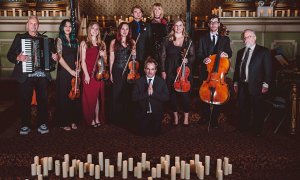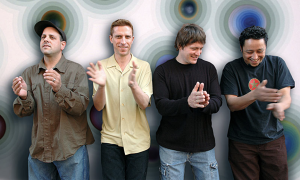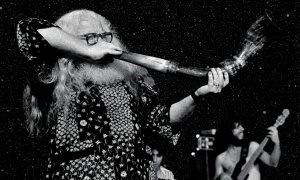Home » Jazz Articles » From the Inside Out » A Period of Transition: Miles @ the Blackhawk 1961
A Period of Transition: Miles @ the Blackhawk 1961
It may be helpful to describe these sets as the closest that Davis came to playing in the soulful school of hard-bop.
After completing these sessions, Davis booked his quintet – with Mobley, Cobb, Chambers, and Kelly – for two nights at one of the most famous jazz clubs on the West Coast, the Blackhawk in San Francisco, and made arrangements to record the shows. Almost incredibly, though the trumpeter was by this time in his third decade of performing and recording, this was to be the first recording of a Davis band live in concert for an official album release.
On June 3, Sony Legacy released all the material from this engagement in two two-CD sets under a single cover. Some of this music had been previously released in varying configurations. But now you can hear every note of every song this ensemble played, through three sets on Friday April 21 and four sets on Saturday April 22, uncut and in chronological order, exactly as they laid it down, for the first time.
Davis’ repertoire for these shows was familiar originals, standards, material from the upcoming Someday album, and bop classics from Dizzy Gillespie, Sonny Rollins, and Thelonious Monk. In this live setting, an increase in the volume of Miles’ playing – not just the amplitude but also the amount – is immediately noticeable when compared to Davis’ other recordings from around this time. Him and his guys were blowin’ .
Though employing such stylistic distinctions often causes more difficulty than it solves, it may be helpful to describe these sets as the closest that Davis came to playing in the soulful school of hard-bop tenured by Art Blakey, Horace Silver, and others.
 Miles Davis in Person at the Blackhawk: Friday Night
Miles Davis in Person at the Blackhawk: Friday Night
Davis played three sets on Friday night. Disc one presents the first and third sets, and disc two the second. Though a quintet in number, all five members rarely play at once; most often, when Davis solos Mobley lays out, and the reverse, so this group functionally sounds like a trumpet or saxophone quartet, depending upon who’s up front.
This first song / first set version of Rollins’ “Oleo” serves notice that Davis is intent on driving it straight and hard all night long. It seems to inspire his ensemble: Mobley and Kelly duel powerfully, the saxophonist with bluesy runs and the pianist with rhythmically and harmonically pungent chords. “Oleo” tumbles headlong into a roaring 17-minute “No Blues,” which Cobb and Chambers drive even harder and faster. Davis solos for the full first five minutes, smearing blue tones (despite the title) like a New Orleans trombone before giving way to Mobley. Kelly then dances in like some sort of bouncy Horace Silver-Hank Jones hybrid...all rather amazing stuff.
In “If I Were A Bell,” “All of You,” and “On Green Dolphin Street,” Davis employs a lyrical style rarely heard after he “went electric” with Bitches Brew at the end of this decade – almost garrulous trumpet that incisively cuts to deep blues through sketching mere fragments of a melodic phrase, and can make something as basic as “Bye Bye Blackbird” swing cool and nasty. Kelly’s elegant phrasing opens the perfect onramp for Davis’ delicate glissandos and luxurious figures “On Green Dolphin Street.” In every set, Kelly moves the rhythms and harmonies along as sassily as Ellington or Basie; combined with such solo turns as his gorgeous “Love, I’ve Found You” that closes the second set, Friday Night demonstrates that Wynton Kelly was playing the piano as well as anybody in 1961. Mobley sort of fits right in as a Davis saxophonist between John Coltrane and Sonny Rollins, not quite with the overpowering presence of the former but with much of the clever dexterity and inquisitiveness of the latter.
 Miles Davis in Person at the Blackhawk: Saturday Night
Miles Davis in Person at the Blackhawk: Saturday Night
Folks in attendance almost had to know that they were in the presence of greatness this evening.
The first set makes incredible physical demands on the rhythm section because it’s essentially an up-tempo jaunt through “If I Were A Bell” and the famous leadoff track from Kind of Blue, “So What,” taken at an almost ridiculously fast tempo, each version more than twelve minutes long. Davis enters his first solo in “Bell” several beats early, borrowing one of Charlie Parker’s favorite devices for creating momentum early in a solo. Though this juiced-up “So What” seems to move almost too quickly, Mobley and Kelly revel in their own sounds, Mobley more throaty and deep, Kelly more articulately rhythmic and blue. Davis also sounds more muted and pensive, rolling over a phrase like he’s examining it his mouth like a wine-taster.
In the second set, after a tumultuous “Walkin’” (which comes off more as a sprint and features explosive drum / trumpet passages), Davis downshifts the ensemble and mood into Thelonious Monk’s classic modern jazz ballad “‘Round Midnight.” You’d swear that Monk composed this inscrutably blue melody specifically for Davis’ mysterious trumpet sound; at this slower tempo, Mobley sounds more deeply reflective and blue, too. Monk’s “Well You Needn’t” ends the set on an upswing.
A previously unreleased, gentle yet strong, version of “Autumn Leaves” opens the third set. Davis commands the spotlight and Mobley really shines, as if he had been aching to play a straight-up ballad and groan some moanin’ blues. Davis later whipsaws the band through Dizzy Gillespie’s “Two Bass Hit,” Chambers quickstep walking in perfectly timed notes.
The entire fourth set from Saturday Night was previously unreleased. It is rather romantic, featuring the ballads “I Thought About You,” and “Softly As In A Morning Sunrise,” and previewing “Someday My Prince Will Come.” Davis’ tone and timing are simply exquisite in “I Thought About You,” his best performance across the two nights. He also gets quite playful with the melody during his “Someday” solo, a light feeling heightened by Kelly’s echoes of Vince Guaraldi in his underlying chords and almost Disney whimsy in his own subsequent solo. Mobley and Davis lay completely out of “Softly As In A Morning Sunrise,” featuring the rhythm section, especially pianist Kelly, to end this engagement.
For this new package, the original liner notes by San Francisco beat columnist ralph j. gleason are supplemented with additional new notes by trumpeter Eddie Henderson, who was in the audience both nights (Henderson’s stepfather was Davis’ doctor and good friend, and Davis often stayed at Henderson’s home when Davis was in California). Henderson’s writing is insightful and detailed (as befits a psychiatrist, his other profession). He notes, for example, that Davis used a French horn mouthpiece, and concludes that, “The difference between the band with Coltrane and Adderley and the Blackhawk band was that the band with Mobley, Kelly, PC and Cobb was more in touch with the ‘people.’ The audience could recognize the tunes. And it swung.”
< Previous
Crosby-Lee-Clooney Remembrance
Comments
Tags
For the Love of Jazz
 All About Jazz has been a pillar of jazz since 1995, championing it as an art form and, more importantly, supporting the musicians who create it. Our enduring commitment has made "AAJ" one of the most culturally important websites of its kind, read by hundreds of thousands of fans, musicians and industry figures every month.
All About Jazz has been a pillar of jazz since 1995, championing it as an art form and, more importantly, supporting the musicians who create it. Our enduring commitment has made "AAJ" one of the most culturally important websites of its kind, read by hundreds of thousands of fans, musicians and industry figures every month.






















